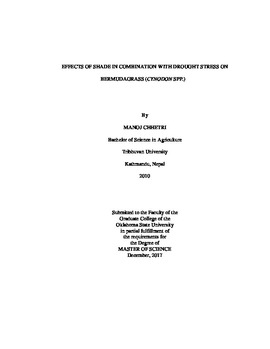| dc.description.abstract | Bermudagrass (Cynodon spp.) is the predominant warm-season turfgrass in the U.S., largely due to its excellent adaptation and stress tolerance. However, bermudagrasses are not adapted to shaded environments. A three-year field study was conducted from 2014 through 2016 to test the shade tolerance of bermudagrass including two Oklahoma State University experimental genotypes (OKS 2011-1 and OKS 2011-4) and eight commercial cultivars of bermudagrass (‘Latitude 36’, ‘Northbridge’, ‘Riviera’, ‘Yukon’, ‘Patriot’, ‘Celebration’, ‘TifGrand’, and ‘Princess 77’). Bermudagrasses were evaluated under a combined neutral and vegetative shade environment: severe shade (75 % shade), moderate shade (49 % shade), and open sun (0 % shade). In terms of cumulative turf performance, Northbridge and Celebration were the top two performers in moderate shade and severe shade, respectively. Patriot was the worst performing cultivar under severe shade. Under severe shade, each cultivar demonstrated turf quality below the ‘minimally acceptable’ threshold.Shade and drought stress commonly co-exist in managed turfgrass systems. Two greenhouse experiments tested the hypothesis that shade would reduce the severity of drought stress on common bermudagrass [C. dactylon (L.) Pers.] and interspecific hybrid bermudagrasses (C. dactylon x C. transvaalensis) as compared to a non-shaded environment. The cultivars Celebration, Latitude 36, and Patriot were established from washed plugs in 10 cm diameter x 45cm long pots filled with a 1:1 top soil: sand root-zone. ‘Non-shade’ and ‘Shade’ (58% shade) treatments were applied using a black shade fabric. Irrigation was applied manually with treatments being either well-watered (100% ET) or drought-stressed (50% ET). Data collected included TQ, NDVI, leaf relative water content, leaf electrolyte leakage, and evapotranspiration rate. Patriot had the poorest performance in drought stress alone, shade alone or combined shade and drought stress treatments. Whereas, Celebration and Latitude 36 performed similarly under each treatment. Shade delayed visible bermudagrass drought stress symptoms by one week in the first experiment, but no delay in drought stress was detected in the second experiment. | |
